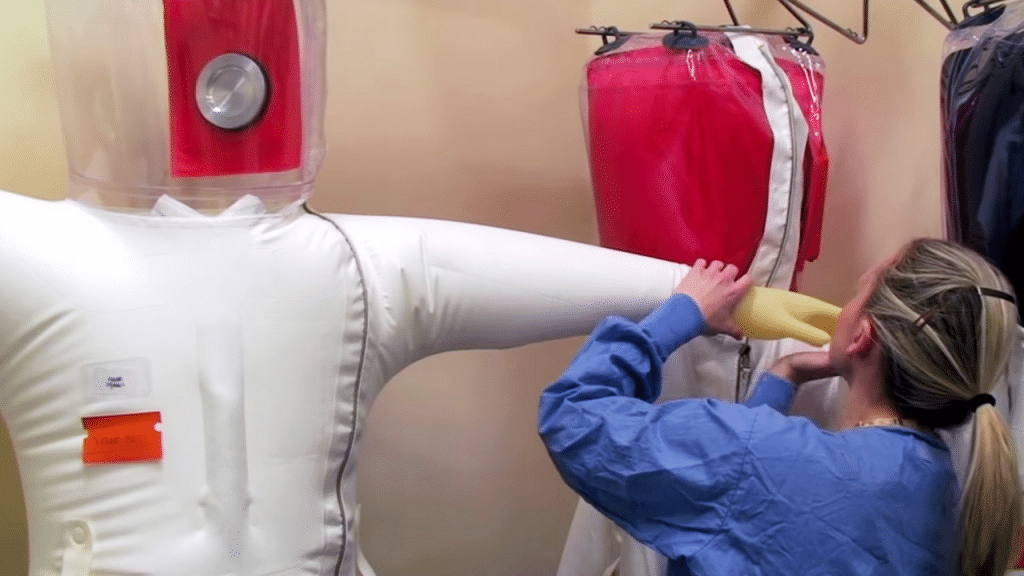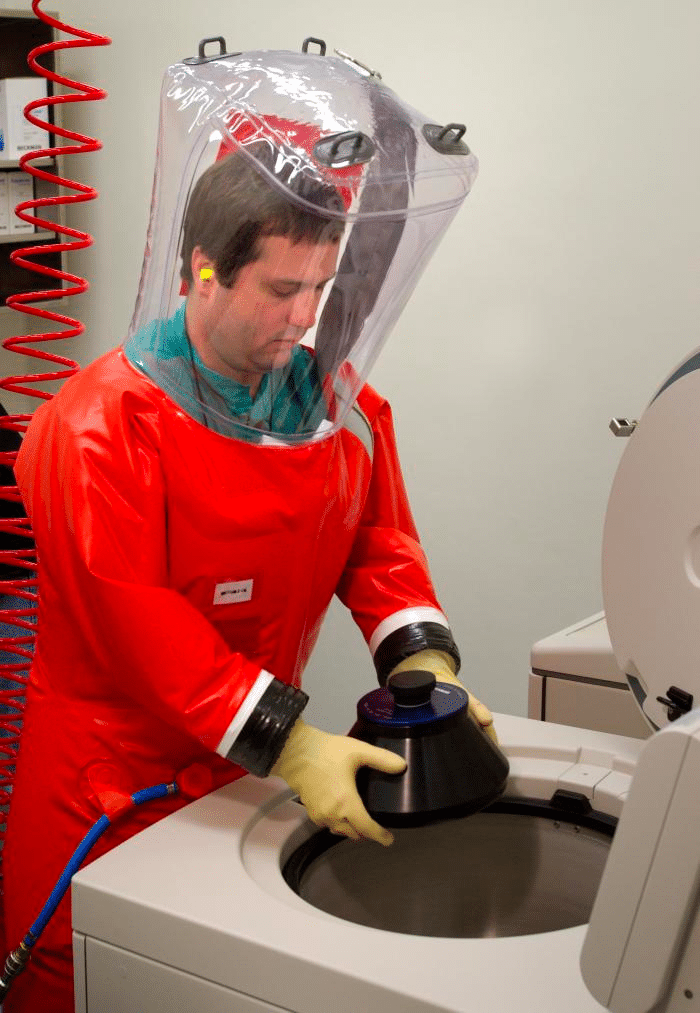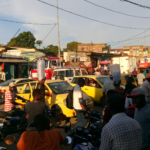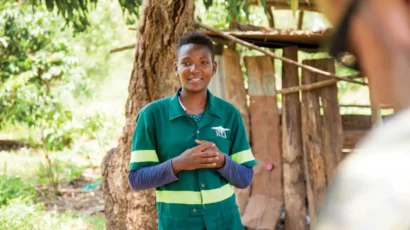How to make sure the labs researching the most dangerous pathogens are safe and secure
By Joseph Rodgers, Filippa Lentzos, Gregory D. Koblentz, Minh Ly | July 2, 2021
 A researcher at the National Institute of Allergy and Infectious Diseases Integrated Research Facility in Frederick, Maryland. inspects a positive-pressure suit, one of the tools lab workers use to protect themselves in biosafety level 4 (BSL-4) labs.
A researcher at the National Institute of Allergy and Infectious Diseases Integrated Research Facility in Frederick, Maryland. inspects a positive-pressure suit, one of the tools lab workers use to protect themselves in biosafety level 4 (BSL-4) labs.
Since 2001, biological risks—from terror attacks involving anthrax letters to outbreaks of new and re-emerging infectious diseases like SARS, Ebola, H5N1 avian influenza, MERS, and Zika—have been galvanizing a global construction boom of research labs meant for work on the deadliest pathogens. These biosafety level 4 labs (BSL-4) are the kind of facilities where researchers have to work in protective gear resembling spacesuits and decontaminate once they finish. Today, 23 countries have built 59 of these state-of-the-art labs, part of a trend that seems unlikely to stop soon. As scientists seek to better understand viruses like the one that causes COVID-19, they will likely need more labs tailor-made for work with risky germs.
The surging number of BSL-4 labs and a corresponding expansion in the research they’re used for is not without risks. While work in the labs generally aims to further scientific knowledge of pathogens and aid in the development of new vaccines and therapeutics, BSL-4 research could also pose significant risks to safety and security. A lab accident could, for instance, lead to workers getting infected and even spreading a disease in their communities. Advanced labs might also engage in so-called “dual use” research of concern—work that is conducted for peaceful, scientific purposes but that generates knowledge or technology that could be readily misused to cause harm, say in the development of a biological weapon. Yet another risk stemming from the proliferation of labs is that adversarial countries could seek to match one another’s investment in advanced research facilities, viewing such spending as an indication of weapons-related research.
As it stands, there is substantial room for improvement in the policies that safeguard against lab accidents and the misuse of research.
Only a quarter of the world’s 59 BSL-4 labs are in countries that score highly in a ranking of international biosafety and biosecurity metrics by the US-based Nuclear Threat Initiative. The index measures whether countries have legislation, regulation, oversight agencies, and other facets of sound biorisk management. Furthermore, only three of the countries with BSL-4 labs have policies on dual-use research—meaning that the vast majority of countries with these labs do not conduct oversight of the type of high-risk, gain-of-function research that makes pathogens more dangerous and that has been a central feature in the COVID-19 origins debate.
These are troubling statistics, but countries have also signaled their willingness to cooperate in lab oversight. All countries that maintain BSL-4 labs report their existence in order to fulfill obligations under the Biological Weapons Convention, the treaty banning bioweapons. But given the risks of lab accidents or misuse of research, governments need to do even more. They must strengthen risk management practices in biology labs and reinforce cultures of safety, security, and responsibility. They can do this by adopting international standards of biosafety and biosecurity.
The history of lab accidents and lab-worker infections is disturbingly long, and the possibility that an incident could spark an outbreak cannot be discounted. Nor should policymakers ignore the potential that malevolent actors might misuse research coming out of BSL-4 labs. Worryingly, there is no authoritative international body tracking the number of BSL-4 labs or one mandated to provide research oversight. A stronger biorisk management program is urgently needed. Thankfully, there’s a ready-made program that could fulfill this need.
An international biorisk management system. The International Organization for Standardization, often called ISO, develops environmental, safety, and other standards for a wide-array of products and processes—from information security to child-safety seat anchors to music festivals. In 2019, the organization released ISO 35001, a standard on biorisk management for laboratories that work with dangerous pathogens. Rather than focusing on scientific hardware, the standard emphasizes commitments by top management—to provide adequate resources, to prioritize and communicate biosafety and biosecurity policy, to train staff, to establish performance expectations. The standard also stresses the need for continual improvement of practices and processes to determine the causes of incidents and other issues, to correct problems so they don’t recur, to identify opportunities for improvement, and to recognize and award improvement.
All labs engaging in high-risk research should seek to implement the new standard—not just BSL-4 labs. In countries with BSL-4 standards like the United States, lab workers must wear full-body, air-supplied, positive-pressure suits. They work in specialized biological safety cabinets, decontaminate all materials and shower upon exiting, and air and waste from the lab is filtered before it is released. These labs are for work on the most dangerous pathogens like Ebola and the variola virus that causes smallpox. But, as one might expect, there are other safety levels—BSL-3, 2, and 1. The work done in these labs ranges from handling biological agents that cause potentially lethal diseases like tuberculosis and plague, through those that pose moderate health risks like influenza, HIV and Lyme disease, to biological agents like E. coli that present minimal potential hazards to labs workers and the environment.
While dealing with lesser risks, lower-containment level labs should also be nurturing safe, secure, and responsible working practices. The new ISO standard could help build confidence that participating labs are taking proper precautionary measures.

Other academics and scholars have recognized that the new ISO standard could help enhance workplace safety, particularly as the scale of COVID-19 research has grown tremendously throughout the pandemic. Creating a consistent process for handling pathogens and biological materials that places safety at the center of all management levels across laboratories would be a big step toward reducing the risk of any future accidents.
Members of the Biological Weapons Convention have supported the adoption of standard processes to reduce biorisk. At a recent meeting, several countries, including France, Germany, and Thailand, supported the establishment of the ISO standard because, they noted, industrial standards can help countries implement their treaty obligation to prevent the misuse of biology and biotechnology on their territory. When treaty members meet again to review and make decisions on the treaty implementation, likely in 2022, they should work to rally support behind the new standard.
Overseeing lab standards. For countries to implement the ISO 35001 standard at an international level, they must agree on a third-party entity to systematically validate and certify compliance. Often for ISO standards, this third-party role falls to private companies. But given the specialized skillset required to identify, assess, and validate appropriate biorisk management of cutting-edge research as well as the need to continuously keep abreast of scientific developments, it is unlikely private companies would be capable of playing this third-party auditing role—or even that it would be financially viable for them to do so, with relatively few potential customers. But, several alternative options exist.
The first option is for BSL-4 labs to rely on national regulators to act as the third-party. Most countries already regulate and license BSL-4 labs, so why wouldn’t having a government agency implement the new ISO standard make the most sense? To put the case against this option simply: trust. Take the Wuhan Institute of Virology, the BSL-4 lab studying coronaviruses in Wuhan at the center of the so-called “lab-leak” theory of the pandemic’s origins. Chinese officials insist that no accident or research at the lab led to the pandemic while the US government and others remain suspicious. When countries can’t trust one another’s regulators or officials, how will they trust that a BSL-4 lab is adhering to standards?
A more credible approach would be to use the International Experts Group of Biosafety and Biosecurity Regulators (IEGBBR). This already-existing forum for national regulators to share best practices currently has 11 member countries, including 40 percent of countries with BSL-4 labs. The membership of the group could be expanded and its mission could be enlarged to incorporate the certification of the new ISO standard. The group could also help new or aspiring member countries improve their regulatory capacity.
It might be more viable for government-run labs to have a stand-alone international body, like the International Atomic Energy Agency (IAEA) or the Organization for the Prohibition of Chemical Weapons (OPCW), to monitor implementation of the new ISO standard. In fact, a proposal to create something called the “International Agency for Biological Safety” is already on the table; Kazakhstan introduced the measure at the United Nations General Assembly in 2020. But negotiating over a new international body is no small feat, especially in the current geopolitical environment, and this option would likely take a long time to implement.
There is, however, already an international organization that conducts limited biosafety checks on labs.
The World Health Organization coordinates every-two-year biosafety and biosecurity inspections of the two labs in the United States and Russia that maintain samples of the virus that causes smallpox. The WHO inspection program could be expanded to certify lab compliance with the new ISO standard. At the very least, the program could serve as a model.
When international experts visit the US Centers for Disease Control and Prevention and the Russian Vector Institute for the WHO-led smallpox lab inspections, they inspect the BSL-4 labs, their heating, ventilation, and air conditioning systems, and their waste decontamination systems. They listen to presentations on the labs’ biosafety and biosecurity systems and operations and review standard operating procedures and other documents. At the end of the inspection, the WHO team presents findings and notes the areas for improvement for the next inspection team to follow up on.
Each of these options (and there are more conceivable arrangements) would represent a significant improvement in lab safety. Implementing the ISO standards would also lead to the creation of transparent and credible evidence in the event of an accident or incident; labs would have a standardized paper trail of their procedures and practices. In the event of something like a laboratory accident or even an unusual disease outbreak in the community around the lab, labs could provide these records to national or international authorities, fostering transparency and assisting with emergency response and management.
ISO 35001 is not a panacea. It is not a substitute for national and international legislation or regulation. But currently, BSL-4 labs and other labs that handle hazardous pathogens operate under very different safety and security standards and practices, depending on where they are—and therefore pose a risk that that needs to be addressed.
Together, we make the world safer.
The Bulletin elevates expert voices above the noise. But as an independent nonprofit organization, our operations depend on the support of readers like you. Help us continue to deliver quality journalism that holds leaders accountable. Your support of our work at any level is important. In return, we promise our coverage will be understandable, influential, vigilant, solution-oriented, and fair-minded. Together we can make a difference.
Keywords: BSL-4, Coronavirus, ISO 35001, dual-use, laboratory accidents
Topics: Biosecurity


















If we are serious about biosafety, the first requirement is to move Level-3 and Level-4 labs out of major metropolitan areas. Whether in Boston or Wuhan, such a lab in a major city implies that a worker can walk out the front door to a subway and potentially infect a 100 people on the way home. If an air-borne disease such as Covid where people are infectious before they are sick, the combination of mass transit, high population densities and global air transport assures the pandemic is global before the locals know they have a problem.. If in a more… Read more »
You propose the WHO as an overseer. But the WHO team sent to Wuhan was denied entry and data, and its leader had a conflict of interest because he gave NIH grant money to Wuhan. Clearly WHO itself is
suspect. It is beyond belief that China would allow a full inspection and data to any independent body. It is a rogue state.